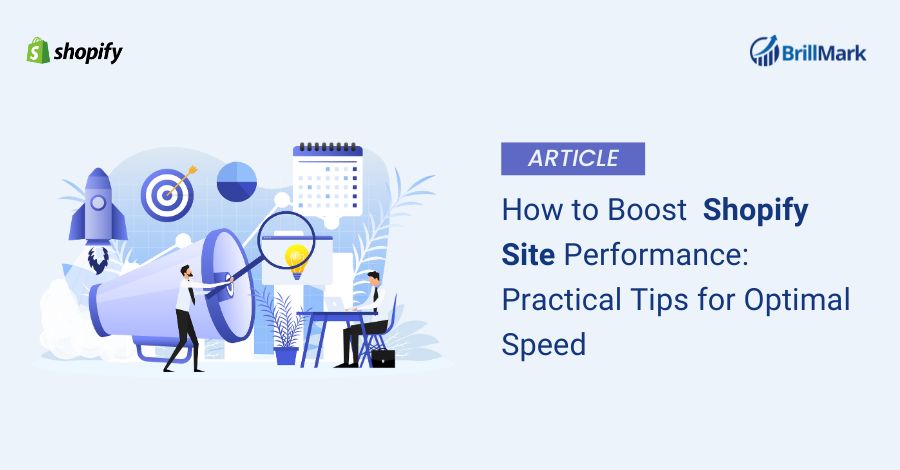If you manage an online store on Shopify, you understand the critical role a speedy and responsive website plays.
Shopify speed optimization is the practice of enhancing your site’s performance to improve its load time, consequently providing a superior user experience along with Shopify growth.
The optimization of website speed involves two crucial metrics: page speed and site speed.
Page speed refers to the time taken for a single page to load, while site speed represents the average load time of a selection of pages.
Both metrics are influenced by various factors like your theme, images, code, apps, and tracking codes.
Also, you can start with the Shopify ab testing to determine which factor you should optimize for Shopify optimization.
Why is website speed essential for e-commerce businesses?
- Website speed affects customer behavior. A Google study shows that 53% of mobile users abandon a site that takes over 3 seconds to load.Moreover, a one-second delay in page load time can reduce conversions by 7%, page views by 11%, and customer satisfaction by 16%.
- Website speed impacts SEO rank. Google uses site speed as a ranking factor for both desktop and mobile searches.
A faster site can assist you in ranking higher on search engines, driving more organic traffic to your store. - Website speed affects the conversion rate. A quicker site can help boost your sales and revenue.
According to a Shopify case study, a mere 0.1s improvement in site speed can increase conversion rates by 8%.
As demonstrated, enhancing your site speed and performance can significantly impact your online store’s success.
In this article, we’ll share some best practices and tips to optimize your Shopify store’s speed and performance, informed by the latest research and data.
We’ll also provide some examples & tools you can use to measure and boost your site speed.
Factors You Can’t Control
Before we delve into the factors within your control, it’s important to recognize that some elements affecting your online store speed are outside your control.
These factors include the user’s device, network, and location.
For instance, if a customer is using an outdated or slow device, has a weak internet connection, or is located far from your server, their site loading time will be slower compared to a customer using a newer or faster device, has a robust internet connection, or is closer to your server.
Thankfully, Shopify’s infrastructure helps with some of these factors, such as providing a world-class CDN (content delivery network), local browser cache, server-side page cache, and optimized assets.
CDN
This reduces the distance between your customers and your site content, resulting in faster loading times.
Local browser cache
This reduces the number of requests and downloads needed to load your site content, resulting in faster loading times.
Server-side page cache
This reduces the processing time needed to generate your site content dynamically, resulting in faster loading times.
Optimized assets
The files that make up your site content, such as HTML, CSS, JavaScript, images, fonts, etc. Shopify automatically optimizes these assets by compressing them or converting them to more efficient formats.
Factors You Can Control
Now that we’ve covered the factors outside of your control, let’s examine those within your control and how to address them.
These factors rely on your choices and actions as a store owner or developer.
In this section, we will discuss the following sub-sections with brief descriptions:
Choose a Lightweight Shopify Theme
One of the most important factors that affect your site’s speed and performance is your theme.
Your theme, which determines the layout, design, functionality, and features of your online store, significantly affects your site’s speed and performance.
However, not all themes are equal in terms of speed and performance.
Some themes are “heavier” than others due to their complex code, extra features, animations, or effects that can slow down your site’s load time.
Therefore, we recommend choosing a responsive and mobile-friendly theme optimized for speed.
Examples of lightweight Shopify themes include Debut, Fastor, Booster, and others.
Find more lightweight Shopify themes: Best Shopify 2.0 Themes for 2023
Reduce Large Image Sizes
Another important factor that affects your site speed and performance is your images.
Images are vital for showcasing your products and brand, but they can also be the largest files on your site.
Large images can slow down your site’s load time and consume bandwidth, especially on mobile devices.
Therefore, we recommend resizing your images to fit the dimensions of your site layout and using tools like Shopify Image Resizer to reduce image file sizes.
Compress Images
In addition to resizing your images, you can further compress them to reduce image file sizes without compromising quality.
Image compression is the process of removing unnecessary data from your images, such as metadata, color profiles, or hidden pixels.
We recommend using tools like to compress your images before uploading them to your site.
Replace GIFs with Static Images
While GIFs are fun, they can also be larger files than static images and usually take longer to load.
Therefore, we recommend replacing GIFs with static images or videos whenever possible, or using tools to optimize GIFs.
Lazy Load Images
Lazy loading can enhance your site speed by loading images only when they are in view.
This means that instead of loading all the images on your site at once, only the images that are visible on the screen are loaded, while the rest are loaded as the user scrolls down.
Lazy loading can reduce the number of requests and downloads needed to load your site content, resulting in faster loading times and lower bandwidth consumption.
It can also improve user experience by preventing blank spaces or broken images from appearing on your site.
Limit Third-Party JavaScript & Shopify Apps
Third-party JavaScript and Shopify apps are external scripts or codes that add functionality or features to your site, such as analytics, social media widgets, reviews, pop-ups, countdown timers, etc.
Third-party JavaScript and Shopify apps can add functionality to your site but can also impact its performance.
Each request adds time to your site loading time, while each code adds weight to your site size.
Therefore, we recommend minimizing the number of apps you use and removing any unnecessary or unused ones.
You should also review the performance impact of each app and choose the ones that are optimized for speed.
Migrate Tracking Codes to Google Tag Manager
Tracking codes allow you to collect data from various analytics and marketing tools, but they can also slow down your site’s load time.
However, these codes can also slow down your site loading time by adding extra scripts to your site.
Each script adds time to your site loading time, while each code adds weight to your site size.
Therefore, we recommend using Google Tag Manager to manage all your tracking codes in one place and load them asynchronously or conditionally.
To use GTM for your Shopify store in a more optimized manner feel free to reach out to our talented team of developers.
Review and Remove Unnecessary Code
Lastly, your code affects your site’s speed and performance.
Your code is the set of instructions that tells your site how to look and behave.
However, sometimes your code can contain unused or redundant elements that can affect your site speed and performance by increasing the size of your HTML, CSS, and JavaScript files.
These elements can include Comments, Whitespace, Unused selectors, and Unused variables.
Therefore, we recommend reviewing and removing any unnecessary code from your theme files or using tools to minify your code.
How to Measure and Monitor Your Site Speed
Now that we’ve discussed improving your site speed and performance, let’s talk about how to measure and monitor it regularly to identify any issues or opportunities for improvement.
There are many tools that you can use to measure and monitor your site speed, such as Google PageSpeed Insights or GTmetrix.
These tools can provide you with various metrics and insights on how fast or slow your site is loading, such as:
- Load time
- Page size
- Requests
- Speed score
- Optimization suggestions
To use these tools, you need to enter your site URL and choose a test location or device.
Then, you need to analyze the results and take action based on them.
For example, if you find that your load time is too long, you can check which files or requests are taking the most time and try to reduce them.
If you find that your page size is too large, you can check which files or requests are taking the most space and try to optimize them.
If you find that your speed score is too low, you can check which optimization suggestions are relevant for your site and try to implement them.
Conclusion
In this article, we’ve shared some best practices and tips on how to optimize your Shopify store’s speed and performance.
By enhancing your site speed and performance, you can provide a superior user experience, rank higher on search engines, and boost your conversions and revenue.
We hope you found this article helpful and informative.
If you have any questions or need assistance with Shopify site speed optimization, please don’t hesitate to contact us.
Reach out to experts like Brillmark to help you maximize your business’s potential.
We are always delighted to help.











